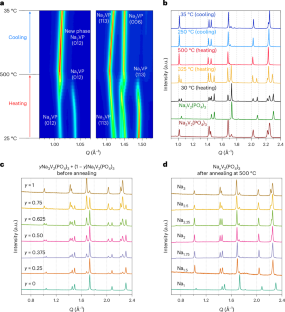2024-12-20 ヒューストン大学
<関連情報>
- https://uh.edu/news-events/stories/2024/december/12202024-canepa-batteries.php
- https://www.nature.com/articles/s41563-024-02023-7
単相NaxV2(PO4)3(1 < x < 3)正極材料からのナトリウム抽出によるV2(PO4)3の取得 Obtaining V2(PO4)3 by sodium extraction from single-phase NaxV2(PO4)3 (1 < x < 3) positive electrode materials
Sunkyu Park,Ziliang Wang,Kriti Choudhary,Jean-Noël Chotard,Dany Carlier,François Fauth,Pieremanuele Canepa,Laurence Croguennec & Christian Masquelier
Nature Materials Published:23 October 2024
DOI:https://doi.org/10.1038/s41563-024-02023-7

Abstract
We report on single-phase NaxV2(PO4)3 compositions (1.5 ≤ x ≤ 2.5) of the Na super ionic conductor type, obtained from a straightforward synthesis route. Typically, chemically prepared c-Na2V2(PO4)3, obtained by annealing an equimolar mixture of Na3V2(PO4)3 and NaV2(PO4)3, exhibits a specific sodium-ion distribution (occupancy of the Na(1) site of only 0.66(4)), whereas that of the electrochemically obtained e-Na2V2(PO4)3 (from Na3V2(PO4)3) is close to 1. Unlike conventional Na3V2(PO4)3, when used as positive electrode materials in Na-ion batteries, the NaxV2(PO4)3 compositions lead to unusual single-phase Na+ extraction/insertion mechanisms with continuous voltage changes upon Na+ extraction/insertion. We demonstrate that the average equilibrium operating voltage observed upon Na+ deintercalation from single-phase Na2V2(PO4)3 is increased up to an average value of ~3.70 V versus Na+/Na (thanks to the activation of the V4+/V5+ redox couple) compared to 3.37 V versus Na+/Na in conventional Na3V2(PO4)3, thus leading to an increase in the theoretical energy density from 396.3 Wh kg–1 to 458.1 Wh kg–1. Electrochemical and chemical Na+ deintercalation from c-Na2V2(PO4)3 enables complete Na-ion extraction, increasing energy density.


